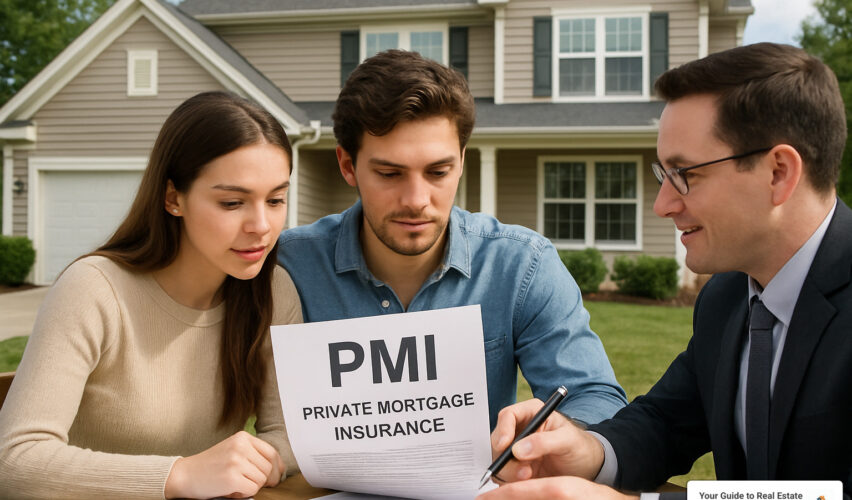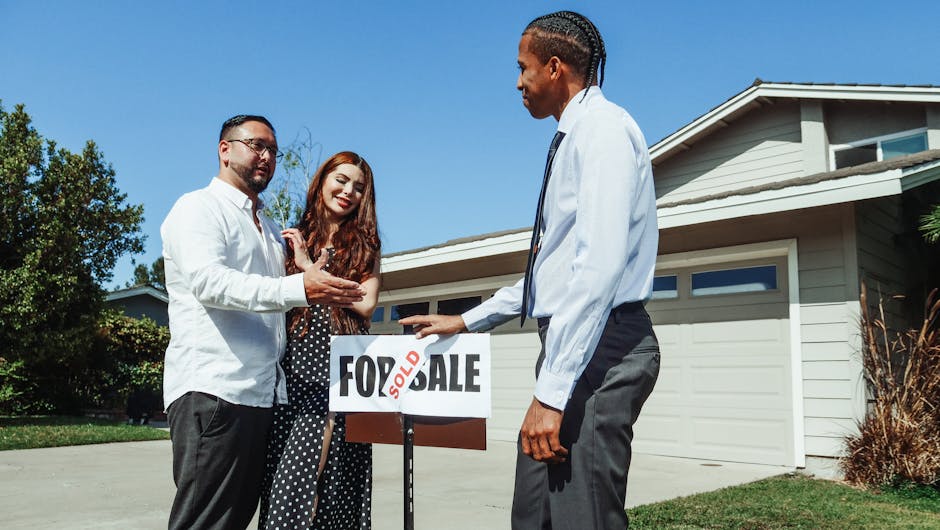Cracking the PMI Code: What Every Homebuyer Needs to Know
Understanding private mortgage insurance (PMI) is essential for anyone buying a home with less than 20% down payment. Here’s what you need to know:
- Definition: PMI is an insurance policy that protects lenders (not you) if you default on your mortgage
- Requirement: Required on conventional loans with less than 20% down payment
- Cost: Typically $30-$70 per month for every $100,000 borrowed (0.46%-1.5% annually)
- Cancellation: Automatically terminates at 78% loan-to-value ratio or can be requested at 80%
- Purpose: Enables homebuyers to purchase with a smaller down payment
For many first-time homebuyers, saving for a 20% down payment feels like climbing Mount Everest. The median home price of $384,500 (as of February 2024) means you’d need nearly $77,000 in cash—a daunting sum that could take years to save.
This is where private mortgage insurance enters the picture. While nobody loves paying for insurance that protects someone else, PMI serves as a bridge that helps millions of Americans become homeowners sooner rather than later.
Since 1957, nearly 39 million low down payment households have been able to purchase or refinance homes thanks to private mortgage insurance. Without it, many would still be renting and missing out on building equity.
Think of PMI as the price of admission to homeownership when you haven’t saved that full 20% down payment. It’s not permanent—once you build enough equity, you can wave goodbye to those monthly premiums.
The choice often comes down to this: pay PMI now and start building equity in your own home, or keep renting while saving for a larger down payment. For many buyers in today’s competitive market, the former makes more financial sense, especially when you consider rising home prices and potential interest rate changes.

Understanding private mortgage insurance glossary:
– how to shop mortgage
– mortgage payment calculator online
– understanding escrow process
What This Guide Covers
In this comprehensive guide, we’ll explain private mortgage insurance by answering all your pressing questions in plain English. We’ll cover everything from what PMI is and why lenders require it to how much it costs and when you can get rid of it. You’ll learn about:
- The difference between PMI and other types of mortgage insurance
- How PMI is calculated and paid
- Your legal rights regarding PMI cancellation
- Strategies to avoid or eliminate PMI sooner
- Alternatives to conventional loans with PMI
By the end, you’ll have actionable tips to make informed decisions about your mortgage and homebuying journey. No jargon, no confusion—just clear guidance to help you steer PMI.
What Is PMI & Why Do Lenders Require It?
When you’re dreaming of homeownership but don’t have a 20% down payment saved up, understanding private mortgage insurance becomes crucial to your journey. PMI is essentially an insurance policy that protects mortgage lenders—not you—if you were to stop making payments on your loan.
Think of it this way: when you make a smaller down payment, you’re asking the lender to take on more risk. Statistics consistently show that borrowers with lower down payments have higher default rates, which makes lenders understandably nervous.

PMI works as a safety net for lenders in three important ways:
First, it provides risk mitigation. When foreclosures happen (which nobody wants), lenders almost always lose money. PMI covers a portion of that potential loss—typically between 20% and 30% of your mortgage balance.
Second, it satisfies secondary market requirements. Financial giants Fannie Mae and Freddie Mac simply won’t purchase or guarantee mortgages with loan-to-value ratios above 80% unless they have private mortgage insurance. This is actually a federal regulation designed to maintain stability in the housing market, according to Urban Institute data on PMI benefits.
Third, and perhaps most importantly for you as a homebuyer, PMI enables expanded lending. Without it, lenders would likely require everyone to have that full 20% down payment, which would put homeownership out of reach for millions of Americans.
PMI vs. Other Mortgage Insurance Types
Not all mortgage insurance is created equal. Different loan programs have their own approaches to handling risk:
With conventional loans and PMI, you’re required to have insurance when your down payment is under 20%. The good news? You can cancel it once you build enough equity (we’ll talk more about that later). Your premium will vary based on your credit score, loan-to-value ratio, and loan term, typically costing between 0.46% and 1.5% of your loan amount each year.
FHA Mortgage Insurance Premium (MIP) works differently. It’s required on all FHA loans regardless of down payment size and includes both an upfront premium (1.75% of your loan amount) and an annual premium (0.15%-0.75%). The catch? For most loans originated after June 2013, you’ll pay this insurance for the entire life of your loan if your down payment was less than 10%. The only way out is refinancing to a conventional loan.
If you’re eligible for a VA loan, you’ll pay a one-time VA Funding Fee instead of ongoing mortgage insurance. This fee ranges from 1.25% to 3.3% of your loan amount depending on your service type and down payment. Many veterans choose to finance this into their loan amount. And here’s a valuable benefit: certain disabled veterans may be completely exempt from this fee.
For rural homebuyers using USDA loans, there’s a USDA Guarantee Fee consisting of both an upfront fee (0.60%-0.65%) and an annual fee (0.25%-0.35%). Like FHA loans, this insurance can’t be canceled during the life of your loan.
The key takeaway? Conventional PMI gives you a path to eventually eliminate the extra cost once you’ve built equity, while government-backed loan insurance typically stays with you for the life of the loan.
Who Does PMI Protect?
Let’s clear up a common misunderstanding: PMI doesn’t protect you as the borrower. Not even a little bit.
If you were to fall on hard times and stop making mortgage payments, PMI won’t prevent foreclosure, cover your payments, protect your credit score, or pay off your mortgage. It solely exists to reimburse the lender for a portion of their losses if you default.
Understanding private mortgage insurance means recognizing it as your ticket to homeownership with a smaller down payment—not as a personal safety net. It’s like paying for insurance on a rental car; it protects the company that owns the car, not you as the driver.
This is precisely why financial experts typically recommend having your own financial protection in place, such as an emergency fund that can cover 3-6 months of mortgage payments. While PMI helps you get in the door of your new home sooner, you’ll still need your own umbrella for those rainy days.
Cost, Payment Options & Budget Impact
Let’s talk money. The price tag for understanding private mortgage insurance varies quite a bit, typically running between 0.46% and 1.5% of your loan amount annually. In everyday terms, that’s about $30 to $70 each month for every $100,000 you borrow.
So what does this mean for your wallet? If you’re buying a $300,000 home with a smaller down payment, you might pay between $90 and $210 monthly for PMI. That’s roughly the cost of a few dinner dates or a modest car payment—not insignificant, but potentially worth it to get into your home sooner.
Your actual PMI cost depends on several key factors. Your credit score plays a huge role—borrowers with excellent scores (760+) enjoy the lowest rates, while those with scores hovering around 620-640 pay considerably more. Your down payment amount matters too—the smaller your down payment (and thus higher loan-to-value ratio), the more expensive your PMI becomes.
Other factors affecting your PMI rate include your loan term (15-year mortgages typically have lower PMI than 30-year loans), loan type (fixed-rate mortgages usually cost less than adjustable-rate mortgages), and even your property type (single-family homes generally get better rates than condos or investment properties).

To put this in perspective, here’s how different down payments affect PMI on a $300,000 home:
| Down Payment | Loan Amount | Approximate Monthly PMI | Annual PMI Cost |
|---|---|---|---|
| 5% ($15,000) | $285,000 | $171-$356 | $2,052-$4,275 |
| 10% ($30,000) | $270,000 | $122-$270 | $1,458-$3,240 |
| 15% ($45,000) | $255,000 | $65-$153 | $780-$1,836 |
As you can see, bumping up your down payment from 5% to 15% could save you over $200 monthly in PMI alone. That’s a nice chunk of change that could cover a utility bill or boost your retirement savings.
How You Pay PMI
When it comes to paying for PMI, you’ve got options—each with its own pros and cons:
The monthly premium approach is what most homebuyers choose. It’s simply added to your regular mortgage payment alongside principal, interest, taxes, and homeowners insurance. It’s convenient and adjusts automatically if your loan balance changes.
If you prefer to avoid monthly payments, single-premium PMI lets you pay the entire amount upfront at closing. You can pay in cash or roll it into your loan. While this eliminates the monthly PMI charge, keep in mind that you won’t get a refund if you sell or refinance earlier than expected. This option often makes sense if you’re planning to stay put for at least five years.
The split-premium PMI offers a middle ground—you pay part at closing and the rest monthly. This gives you lower monthly payments than standard PMI, which can be helpful if your debt-to-income ratio is tight.
With lender-paid PMI (LPMI), your lender covers the PMI premium, but you’ll pay a higher interest rate in exchange. Unlike regular PMI, this can’t be canceled when you reach 20% equity. This might benefit high-income borrowers who can take advantage of the mortgage interest tax deduction.
When reviewing your loan paperwork, you’ll find monthly PMI listed on page 1 of your Loan Estimate and Closing Disclosure, while upfront premiums appear on page 2 in section B.
How PMI Affects Total Homeownership Cost
Understanding private mortgage insurance means looking beyond the monthly payment to see the big picture of your homeownership journey.
While PMI adds to your monthly expenses, consider the opportunity cost of waiting to buy. If you delay purchasing to save up that full 20% down payment, you’re missing out on building equity and potential home appreciation during that time.
Think about your break-even timeline too. How long would it take for your PMI payments to exceed what you’d save by making a larger down payment? If home values in your target area are rising faster than you can save (that home price appreciation factor), paying PMI now might actually be the smarter financial move.
The interest rate environment also matters. Waiting a few years to save more might mean facing higher interest rates later, potentially costing you far more over the life of your loan than PMI would have.
Let’s look at a real-world example: If you’re eyeing a $300,000 home and can put down 5% ($15,000) now versus waiting two years to save 20% ($60,000):
With 5% down now, you’d pay roughly $2,500/year in PMI. But by waiting two years, you’d miss out on building approximately $12,000 in equity (assuming a modest 4% annual appreciation). Plus, you face the risk of rising interest rates while you’re saving.
In many cases, especially in growing markets, buying sooner with PMI can be financially advantageous. However, if home prices in your area are stable and you can save quickly, waiting might make more sense.
The bottom line? PMI isn’t just an extra cost—it’s a tool that might help you build wealth sooner by getting you into the homeownership game earlier. Your specific situation will determine whether it’s worth it for you.
Understanding Private Mortgage Insurance: Requirements, Duration & Cancellation
If you’re buying a home with less than 20% down, PMI will be part of your homeownership journey – but it doesn’t have to be a permanent companion. Thanks to the Homeowners Protection Act of 1998 (also called the PMI Cancellation Act), you have legal rights that determine exactly when and how you can wave goodbye to those extra monthly payments.
Understanding private mortgage insurance means knowing it’s not a forever arrangement. Think of PMI as a temporary travel companion that eventually leaves once you’ve built enough equity in your home.
Here’s the good news about PMI cancellation milestones:
When your loan balance reaches 78% of your home’s original value (meaning you’ve built 22% equity), your lender must automatically cancel PMI – provided your payments are current. You don’t even need to ask!
Even better, you can take matters into your own hands and request cancellation once you reach 80% LTV (20% equity) based on the original value, as long as you’ve kept up with your payments. And if you somehow haven’t reached either threshold by the midpoint of your loan term (year 15 of a 30-year mortgage, for example), the law requires PMI termination anyway.
These rules apply to loans closed after July 29, 1999. If your loan predates this, cancellation policies might differ, so check with your lender.

These cancellation thresholds are typically based on your home’s original value, not its current market value. However, if your neighborhood has become the hot new place to live and property values have jumped significantly, you might be able to use a new appraisal to show you’ve reached 20% equity faster than expected. Just keep in mind this approach is at your lender’s discretion.
Borrower Rights & Steps to Remove PMI
When you’re ready to kick PMI to the curb, here’s your roadmap to freedom:
Start by tracking your equity progress through your mortgage statements or an amortization calculator. This helps you pinpoint when you’ll hit that magical 80% LTV mark. While you’re building equity, maintain a spotless payment history – most lenders want to see no late payments for at least 12-24 months before they’ll consider your cancellation request.
Once you reach 80% LTV, submit a written request to your loan servicer. Many have specific forms for this purpose, so ask about their preferred process. Be prepared for your lender to request a new appraisal (which you’ll need to pay for) to verify your home hasn’t decreased in value.
After submitting your request, follow up diligently to confirm PMI charges have been removed from your monthly statement. Sometimes these things fall through the cracks, and you don’t want to pay a penny more than necessary!
Be aware that certain situations might complicate your PMI removal journey. Loans considered “high risk” might face stricter cancellation requirements. If you have a second mortgage or home equity line of credit, the path to cancellation might be more complex. And depending on where you live, your state might offer additional PMI protections beyond federal requirements.
If you hit roadblocks with PMI cancellation, don’t give up! Contact your state’s banking department (like the Texas Department of Banking if you’re in the Lone Star State) or the Consumer Financial Protection Bureau (CFPB) for assistance.
PMI During Refinancing
Refinancing offers another escape route from PMI payments. When you refinance, your home gets a fresh appraisal, and your loan-to-value ratio is recalculated based on its current value.
If your home has appreciated enough to give you 20% or more equity, refinancing can help you shed PMI while potentially securing a better interest rate. This strategy works particularly well when your property has increased in value since purchase, you’ve been making extra principal payments, or when interest rates have dropped significantly.
However, refinancing isn’t free – closing costs typically run 2-5% of your loan amount. Before jumping in, calculate whether your PMI savings justify these expenses. Sometimes combining strategies works best – like making a larger payment at closing during refinancing specifically to reach that 80% LTV threshold.
Different refinancing scenarios affect PMI in different ways. A standard rate-and-term refinance still requires PMI if your new loan keeps you above 80% LTV. With a cash-out refinance, taking money out increases your loan amount, potentially pushing you above 80% LTV and requiring PMI even if you didn’t have it before.
Refinancing resets your loan term. Unless you choose a shorter-term loan, you’ll be paying interest for a longer period, which could offset some of your PMI savings. For a deeper dive into refinancing strategies, check out our guide on how to shop mortgage options.
Strategies to Avoid, Reduce or Eliminate PMI Sooner
Let’s face it—nobody loves paying for insurance that doesn’t protect them. If you’re looking to minimize or escape PMI altogether, I’ve got some practical strategies that real homebuyers use every day.
Saving for that full 20% down payment is the most straightforward approach. While it takes longer, it completely eliminates PMI from the equation. Consider setting up automatic transfers to a high-yield savings account—even $100 a week adds up to $5,200 a year. Many of our readers have found success by temporarily cutting back on dining out or subscription services to boost their down payment fund. Don’t forget to explore down payment assistance programs in your area, which might get you to that 20% threshold faster than you think.
The “piggyback loan” strategy (often called an 80-10-10) is another clever approach. Instead of one loan for 90% of your home’s value, you take a primary mortgage for 80%, a second loan (typically a home equity loan) for 10%, and make a 10% down payment. Since your primary mortgage stays at that magical 80% LTV ratio, you avoid PMI entirely. Just keep in mind that second loans usually come with higher interest rates, so do the math carefully.
Once you already have a mortgage with PMI, accelerating your equity building can help you shed those premiums faster. Making extra principal payments whenever possible directly reduces your loan balance, bringing you closer to that 80% LTV milestone. Some homeowners switch to a biweekly payment schedule—paying half your mortgage every two weeks results in 26 half-payments per year (equivalent to 13 monthly payments), helping you build equity faster. Tax refunds, work bonuses, or unexpected windfalls make excellent opportunities for lump-sum principal payments.
In today’s rising real estate markets, home appreciation might do some of the work for you. If property values in your neighborhood have increased significantly since you purchased, consider requesting a new appraisal. If the updated valuation puts your loan-to-value ratio at 80% or lower, you can request PMI removal based on the new value. Be prepared to spend $300-$500 for the appraisal, but if it eliminates years of PMI payments, it’s money well spent.

Some lenders offer what’s called “lender-paid PMI,” where they cover your PMI in exchange for a slightly higher interest rate. This approach eliminates the separate PMI line item from your monthly payment and may provide tax advantages since mortgage interest is potentially tax-deductible while PMI might not be. The downside? Unlike regular PMI, this higher rate can’t be canceled when you reach 20% equity—it’s baked into your loan for its entire term.
A few lenders also offer special programs that waive PMI with down payments as low as 10% for qualified borrowers with excellent credit. These aren’t widely advertised, so you’ll need to shop around. We recommend using our how to shop mortgage guide to compare options from multiple lenders and uncover these hidden gems.
Pros & Cons: Pay PMI Now vs. Wait to Save 20%
This is perhaps the biggest dilemma homebuyers face: should you buy now with PMI or wait until you’ve saved that full 20%? Let’s break down both sides of this decision.
When you buy now with PMI, you start building equity immediately instead of paying rent (which builds someone else’s equity). You also lock in today’s home prices—particularly valuable in rapidly appreciating markets where waiting might cost you more in the long run. Securing current interest rates can be another advantage if rates are projected to rise. The clock also starts ticking on potential property appreciation, which could help you eliminate PMI sooner than expected.
Of course, buying with PMI means higher monthly payments and potentially higher interest rates due to your lower down payment. You’ll have less equity cushion if property values decline, and you’ll pay more total interest over the life of your loan.
Waiting until you’ve saved 20% means you’ll never pay a dime of PMI. Your monthly payments will be lower, you might qualify for better interest rates, and you’ll start with a stronger equity position. The extra time also gives you opportunity to improve your credit score, potentially securing even better loan terms.
The downsides of waiting? You’ll continue paying rent with no equity building. In many markets, home prices rise faster than most people can save, meaning that 20% target keeps moving further away. Interest rates might increase while you’re saving, and you’ll delay the wealth-building advantages of homeownership.
In appreciating markets, the math often favors buying sooner with PMI. Consider this example: if homes are appreciating at 4% annually (a conservative estimate in many markets), a $300,000 home would increase to $324,480 after just two years. If you’re diligently saving $1,000 monthly toward a down payment, you’d have saved $24,000 in those two years—but the additional down payment needed would have increased by nearly the same amount. In this scenario, you’d be running in place financially while missing out on building equity.
Tax Deductibility & Record-Keeping
Understanding private mortgage insurance also means knowing its tax implications. The rules have changed several times in recent years, so staying informed is crucial.
As of 2024, PMI premiums may be tax-deductible if you meet these three conditions: you itemize deductions rather than taking the standard deduction; your adjusted gross income (AGI) falls below certain thresholds; and the mortgage is for your primary residence or a second home that isn’t a rental property.
The deduction begins to phase out when your AGI exceeds $100,000 ($50,000 if married filing separately) and disappears completely at $109,000 AGI ($54,500 if married filing separately).
Since this deduction has been extended and expired several times through congressional action, I recommend checking the current IRS guidelines or consulting with a tax professional before counting on this deduction.
For proper record-keeping (something many homeowners overlook), keep all loan documents showing your PMI terms and save your annual mortgage interest statements (Form 1098) that show PMI paid. Maintain records of any PMI cancellation requests and lender responses. If you’re planning to use home appreciation for early PMI removal, document home improvements that increase value—these can help justify a higher appraisal when the time comes.
Smart PMI management is just one part of savvy homeownership. With these strategies, you can minimize this expense and put more of your hard-earned money toward building equity in your home.
Low-Down-Payment Alternatives Beyond Conventional PMI
If you’re dreaming of homeownership but don’t have a 20% down payment saved up, don’t worry! You’re not limited to conventional loans with PMI. Several government-backed programs can help you get into a home with little money down—sometimes even zero.
FHA Loans offer a popular pathway to homeownership for many first-time buyers. With a credit score of 580 or higher, you’ll only need 3.5% down. Even if your credit sits between 500-579, you can still qualify with 10% down. While FHA loans require both an upfront mortgage insurance premium (1.75% of your loan amount) and annual MIP (ranging from 0.15% to 0.75%), they open doors that might otherwise remain closed. Just remember that if your down payment is less than 10%, you’ll likely pay that MIP for the entire life of the loan.
VA Loans stand out as perhaps the best mortgage product available—if you qualify. Reserved for eligible service members, veterans, and surviving spouses, these loans require no down payment and no monthly mortgage insurance. Instead, you’ll pay a one-time funding fee (between 1.25% and 3.3% of the loan amount), which can be rolled into your mortgage. Many disabled veterans can even have this fee waived entirely. As a bonus, VA loans typically offer lower interest rates than conventional options, making them a tremendous benefit for those who’ve served our country.
USDA Rural Development Loans present another zero-down-payment option, designed to boost homeownership in rural and some suburban areas. Don’t let the “rural” label fool you—many surprisingly accessible areas qualify. These loans do have income limits (typically 115% of the area median income) and include both an upfront guarantee fee (0.60%-0.65%) and an annual fee (0.25%-0.35%). While these fees are lower than FHA options, they cannot be canceled during the life of the loan.
Many states also offer special programs for first-time homebuyers that can make homeownership more affordable. These might include down payment assistance, reduced mortgage insurance premiums, or below-market interest rates. Eligibility typically depends on your income, the property’s location, and your status as a first-time buyer. Our First-Time Homebuyers Toolkit provides detailed information about programs available in your area.
Comparing Lifetime Insurance Costs
When choosing between these options, it’s smart to look beyond the initial payment and consider what you’ll pay over the long haul.
With conventional loans and PMI, you’ll start with higher costs, but the ability to cancel PMI once you reach 78-80% loan-to-value ratio can save you thousands in the long run. This option typically works best if you’ll stay in your home for at least five years and have good credit. The temporary nature of PMI is its biggest advantage—once it’s gone, your payment drops.
Understanding private mortgage insurance costs over time helps explain why FHA loans, while easier to qualify for, often end up being the most expensive long-term option. That lifetime MIP requirement (for loans with less than 10% down) means you’ll keep paying long after you would have canceled PMI on a conventional loan. If you’re planning to stay in your home for seven years or more, this continued cost adds up significantly.
VA loans almost always offer the lowest lifetime cost for eligible veterans, especially those planning long-term ownership. With no monthly insurance premium at all, just that one-time funding fee, the savings compound year after year.
USDA loans fall somewhere in the middle—their guarantee fees are lower than FHA’s MIP, but like FHA, they continue for the life of the loan. For rural homebuyers who meet the income requirements, they’re still an excellent option.
Your best choice ultimately depends on your personal circumstances—your credit profile, how long you plan to live in the home, and which programs you qualify for. A borrower with excellent credit planning to stay put for a decade might find conventional PMI most cost-effective, while a military veteran would almost certainly benefit most from a VA loan’s structure.
Mortgage insurance—in whatever form it takes—serves an important purpose: helping people become homeowners sooner rather than later. By understanding your options, you can choose the path that best balances your immediate needs with your long-term financial goals.
Frequently Asked Questions about Private Mortgage Insurance
How much is PMI on a $300,000 mortgage?
When budgeting for your new home purchase with a $300,000 mortgage, you’ll typically find PMI costs ranging from $90 to $210 monthly. It’s like buying a nice dinner out each month to secure your path to homeownership.
The actual amount varies widely based on your personal financial situation. If you’re putting down just 5% ($15,000), expect to pay toward the higher end—around $150-$210 monthly. Meanwhile, if you’ve saved enough for a 15% down payment ($45,000), your PMI might drop significantly to $90-$120 per month.
Your credit score plays a huge role too. Those with excellent credit (760+) might enjoy PMI as low as $90-$150 monthly, while borrowers with credit challenges (620-640 range) could see payments closer to $150-$210 for the identical loan.
The term of your mortgage matters as well—15-year mortgages generally come with lower PMI rates than their 30-year counterparts. The good news? As you pay down your loan balance, your PMI will gradually decrease since it’s calculated as a percentage of your remaining principal.
When you receive your Loan Estimate during the application process, you’ll see exactly what your lender is proposing for PMI. This transparency helps you compare options and budget accordingly.
Can I avoid PMI with 10% down?
Yes! Even with just 10% saved, you have several creative paths to sidestep those monthly PMI payments.
Many savvy homebuyers opt for what’s called a “piggyback loan” or “80-10-10” arrangement. Here’s how it works: you get a primary mortgage covering 80% of your home’s purchase price, take out a second mortgage (home equity loan) for 10%, and contribute your 10% down payment. Since your first mortgage stays at that magic 80% LTV threshold, you avoid PMI requirements altogether.
Another popular approach is lender-paid PMI, where your lender essentially covers the insurance in exchange for a slightly higher interest rate—typically 0.25% to 0.5% above what you’d otherwise qualify for. The benefit? Your monthly payment might be lower than with traditional PMI, and the additional interest could be tax-deductible (unlike standard PMI, which has income limitations for deductibility).
If you have extra cash available at closing, single-premium PMI lets you pay the entire insurance amount upfront. While you’re still technically paying PMI, you eliminate the monthly payment component.
Some portfolio lenders also offer special programs waiving PMI with just 10% down for well-qualified borrowers with strong credit and income profiles.
Each option comes with its own considerations. The second mortgage in a piggyback arrangement typically carries a higher interest rate. Lender-paid PMI becomes a permanent part of your rate and can’t be canceled when you reach 20% equity. And single-premium PMI isn’t refundable if you sell or refinance earlier than expected.
Does PMI protect me if I lose my job?
This is perhaps the biggest misconception about PMI, and I want to be crystal clear: understanding private mortgage insurance means recognizing it provides zero protection for you if you lose your job or face financial hardship.
PMI exists solely to protect your lender if you default on your loan. If you suddenly can’t make your mortgage payments:
PMI won’t step in to cover a single monthly payment for you. It won’t prevent or delay foreclosure proceedings. It won’t shield your credit score from damage. And it certainly won’t help you keep your home.
The insurance only kicks in after foreclosure to reimburse the lender for a portion of their losses. By that point, you’ve already lost your home and suffered credit damage.
For genuine personal protection, consider alternatives like mortgage disability insurance (which covers payments if you become disabled) or mortgage life insurance (which pays off your home if you die). Building a solid emergency savings fund covering 3-6 months of expenses provides the most flexible safety net.
Some homeowners also explore private unemployment insurance policies specifically designed to cover mortgage payments during periods of job loss—these provide the protection many people mistakenly think PMI offers.
PMI is simply the price of admission to homeownership with a smaller down payment—not a personal financial safety net.
Conclusion
Understanding private mortgage insurance is like mastering an essential chapter in your homebuying story. While nobody loves an extra monthly expense, PMI has helped millions of Americans open up the front door to their own homes without waiting years—or even decades—to save that intimidating 20% down payment.
Throughout this guide, we’ve pulled back the curtain on PMI and what it means for your homebuying journey. So what’s the bottom line?
PMI creates a bridge to homeownership when your savings haven’t quite reached the traditional down payment threshold. Instead of renting while watching home prices climb further out of reach, PMI lets you start building equity now—often with as little as 3-5% down on conventional loans.
PMI serves the lender, not you. It’s their safety net if things go south, covering a portion of their potential losses if you default. But that doesn’t mean it can’t work in your favor strategically.
Your costs will vary significantly based on your financial profile. With excellent credit and a larger down payment, you might pay as little as $30 monthly per $100,000 borrowed. With shakier credit and minimal down payment, that could climb to $70 or more per $100,000. The good news? Unlike some other loan types, conventional PMI is temporary—it falls away once you’ve built 20-22% equity.
As you steer your options, keep these action items in mind:
Monitor your equity position carefully and be proactive about requesting cancellation when you hit that 20% mark. Many lenders won’t automatically remove it at exactly 20%—you’ll need to ask.
When comparing loan programs, look beyond the monthly payment to calculate lifetime costs. A loan with PMI that you can cancel in a few years might cost less overall than alternatives without traditional PMI but with permanent insurance requirements.
Consider your timeline honestly. How long do you plan to stay in this home? This answer should influence whether you choose monthly PMI, lender-paid PMI, or another structure entirely.
Don’t limit yourself to just conventional loans with PMI. Explore FHA, VA, USDA, and state-specific programs that might offer better terms for your situation.
At Your Guide to Real Estate, we believe knowledge creates confident homebuyers who make smarter decisions. PMI shouldn’t be viewed as a penalty for having a smaller down payment—it’s simply one tool in your homebuying toolkit, a stepping stone that might make perfect sense for your situation.
Ready to continue your homebuying education? Our Easy Steps to Buying Your First Home guide walks you through the entire process, while our First-Time Homebuyers Toolkit offers a comprehensive resource collection to support your journey.
Your dream home might be closer than you think—even without that full 20% saved up. Sometimes the smartest financial move isn’t waiting for perfect conditions, but understanding how to use available tools like PMI to create your own path to homeownership.

















